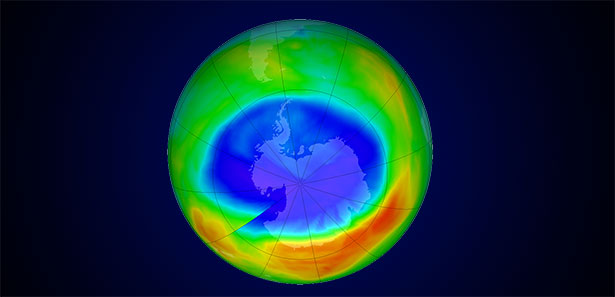Ozone hole as small as in the year 1988
Unusually warm winter has minimized ozone depletion over the Antarctic
Brief respite: The ozone hole over the Antarctic is exceptionally small and weak this year. Measurements show, that with barely 20 million square kilometers surface it was not this small since 1988. But this is not a reason for an all-clear signal, as the researchers emphasize. The cause is an unusually warm winter in Antarctica, not a permanent cure of ozone depletion.

The Earth's ozone layer is our most important protection against harmful UV radiation. But until the Montreal Protocol in 1987, mankind had already released so many chlorine and bromine ozone depleting substances that this protective layer is badly damaged. Even today, 40 years after the ban on these substances, an ozone hole breaks over the Antarctic every year. And even over the Arctic, the ozone layer is still thinned out.
Smaller than in the last 40 years
The ozone layer in 2017 is now being investigated by scientists from NASA and the National Oceanic and Atmospheric Administration (NOAA). They monitor the state of the Antarctic ozone hole both by satellite and by measurements from the US South Pole Station and by weather balloons deposited there.
The result:
The Antarctic ozone hole was unusually weak this year, says Paul Newman of NASA's Goddard Space Flight Center.
The expansion of the ozone hole reached nearly 20 million square kilometers in mid-September and even decreased in size until October. Thus, the ozone hole this year is the smallest since 1988, as the researchers explain.
Less thinned out than usually
The ozone concentration within the ozone hole also fell less strongly in 2017 than in previous years: the scientists calculated a value of 136 Dobson units on average - a value that was last reached in 1988.
In the past, at certain altitudes of the stratosphere, we repeatedly measured zero values, says Bryan Johnson of the NOAA. This year, ozone levels did not even reach zero for any measurement.
However, the ozone layer over the South Pole is still thinned out, as the researchers emphasize. Because usually the ozone layer has values between 300 and 500 Dobson units. This corresponds to a layer of pure ozone about three to five millimeters thick. Only this filters enough UV out of the sunlight to prevent major damage to humans, animals and plants.
Why the ozone hole is so small this year © NASA / GSFCAnomaly, no all-clear
But despite all the positive results: The weak ozone hole is not a reason for an all-clear signal, as the researchers emphasize. Because this is a positive outlier caused by special weather conditions, but not a basic indication for a quick healing of the ozone hole. Until it closes permanently, it will take up to the year 2050 or even 2070, so the estimates.
Instead, the cause of low ozone depletion in 2017 was an unusually warm winter over the Antarctic, as Newman and his colleagues explain. The Antarctic vortex - the air flow circulating around the South Pole - was thus more unstable and warmer than usually, and less polar stratospheric clouds did form. These are considered to be the environment in which the ozone-depleting reactions take place.
In addition, scientists have recently discovered that the emission of another ozone-depleting gas in the atmosphere is rapidly increasing: since the year 2000, the content of dichloromethane has doubled. If this trend continues, the recovery of the ozone hole could be delayed by another 30 years, the researchers warn.
Source: NASA/ Goddard Space Flight Center, 06.11.2017 - NPO

We better be mindful of all of this, otherwise the Earth may end up like Venus: To thick of an atmosphere, a "green house effect" and most importantly, an impossible place for humanity to continue surviving on.
I totally agree!
beautiful post!!!!
Thank you!
Thankfully the ban for no more CFK's in spraycan's was succesful enough. Doesn't even stand on the labeling anymore.
Yes that's true, but sadly, although the replacement substance mostly used (HFA-134a) doesn't harm the ozone layer that much, it stimulates the greenhouse effect.
nice post
Thanks!
It will likely continue getting smaller!
It probably doesn't matter unless mankind pulls their head out of their ass and starts taking care of our environment.
Yes indeed, time is now to take actions!
Congratulations! This post has been upvoted from the communal account, @minnowsupport, by n3bul4 from the Minnow Support Project. It's a witness project run by aggroed, ausbitbank, teamsteem, theprophet0, someguy123, neoxian, followbtcnews/crimsonclad, and netuoso. The goal is to help Steemit grow by supporting Minnows and creating a social network. Please find us in the Peace, Abundance, and Liberty Network (PALnet) Discord Channel. It's a completely public and open space to all members of the Steemit community who voluntarily choose to be there.
This post has received a 0.35 % upvote from @drotto thanks to: @banjo.
This post has received a 3.25 % upvote from @booster thanks to: @n3bul4.